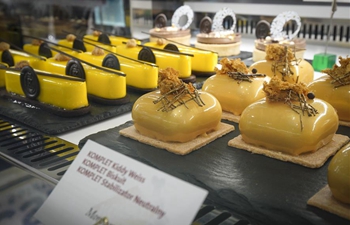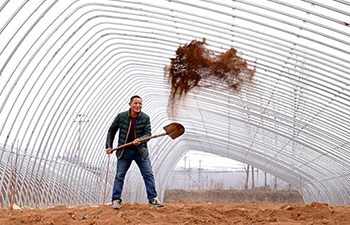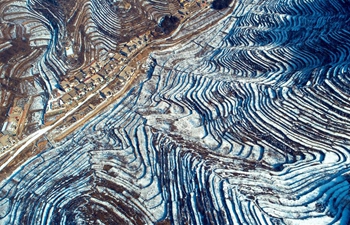NAIROBI, Feb. 18 (Xinhu) -- The little blue machine rotates at a greater speed as dairy farmer Jackson Mutei, a resident of Kamulu, on the outskirts of Nairobi, feeds it napier grass, which it chops into smaller pieces.
The more he pushes in the grass harvested from his farm, the more the tiny chopped pieces pile up on the other side.
The machine, a chaff-cutter, has made work easier for Mutei, who sells produce from his four dairy cows to the nearby Ruai, a bustling residential and commercial center.
The beauty of the machine fabricated in the capital Nairobi, however, is not only in the work that it does, but also in the fact that it runs on biogas produced on the farm.
"The machine used to use petrol but I found someone who remodeled it to use biogas, saving me a lot of money that I would have been using on the fuel," Mutei said on Monday.
He is among an increasing number of Kenyan dairy farmers who are turning to the green energy to power their farms.
They are using the gas generated using cow dung to power their farm machinery and to light their homes, cook food in the kitchen and boil water in the bathroom.
"I embraced the technology over a year ago and it has brought down my cost of production," Mutei said. "When I was relying on petrol, I would use up to four liters every two days to chop fodder because the cows feed a lot. There is a time a liter of petrol was retailing at 115 shillings (1.15 U.S. dollars), which was expensive."
While Mutei does not use the biogas to cook or light his home due to its limited amount, farmer Nelson Kemei, in Bomet County, use the green energy he generates from his 10 cows to cook and light his home.
"I no longer cut down my trees to make firewood or charcoal for cooking because with biogas, it is not necessary. My wife uses the gas to cook all our food, from meat to a mixture of maize and beans, which takes hours to boil," said Kemei.
To make biogas, he explained, a mixture of water cow dung from the dairy unit is put into a bio-digester where it is broken down to produce methane.
"From the bio-digester, the gas flows into the dairy unit and the house through pipes," he said. "But it must first pass through a desulphurizer to remove sulphur in the methane which affects the smooth running of gadgets like chaff-cutters or even the gas cooker."
Kemei said he no longer relies on electricity or petrol to power his farm and home, saving at least 20 dollars every month on power bills and at least 2.5 dollars per day that would have gone on petrol.
"We use the waste from the biogas unit to grow our crops including maize and beans making the dairy enterprise a very profitable venture," he said.
Biogas is produced through anaerobic breakdown of organic matter like animal and crop waste to produce methane, a flammable gas, according to Felix Opinya, a livestock expert at Egerton University.
"Many people find initial costs expensive as one spends some 700 dollars on the smaller unit, but if you do the math, biogas is cheaper in the long-term since the production unit has a life expectancy of up to 30 years," he said.













